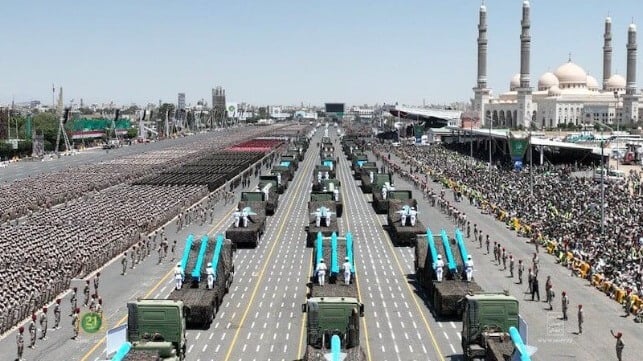Yemen's Houthi Rebels Build New Supply Chains for Maritime Strikes

Yemen's Houthi rebels have been attacking commercial shipping in the Red Sea since last fall, and despite countless efforts at striking their shoreside operations, they have maintained a steady tempo of attacks. Their resilience stems from continued support from their Iranian sponsors, their own in-house abilities, and - in an emerging development - a new diversity of suppliers, according to a top Navy leader.
The Houthis' supply chain has relied on Iran since the beginning of the group's militancy, and over the years, U.S. and allied forces have intercepted multiple Iranian weapons shipments bound for Yemen on the high seas. But the group's supply infrastructure has evolved "far beyond" what it was at the start of the Yemeni civil war 10 years ago, says 5th Fleet Commander Vice Adm. George Wikoff - and it now involves multiple players.
"There is a line of effort right now looking at all supply [lines] coming in to the Houthis, and we don't believe it's limited to the Iranians," said Wikoff in a video interview with CSIS. "The Houthis are diversifying. There's discussion that they could become exporters of the [weapons] technology."
Wikoff questioned the Houthi narrative of fighting for Palestinian rights, noting that the group attacked Saudi shipping for years before it attacked Israeli-linked shipping. The group's antishipping campaign is taking a regional toll, he said, from empty hotels in Aqaba to delayed aid deliveries in Port Sudan to the collapse of Egypt's Suez Canal revenues.
"Two-thirds of the people in Yemen . . . right now are in dire need of humanitarian assistance, and 30 million people are starving in the region," he said. "The Houthis have a narrative of why they're doing what they're doing but at the end of the day they're only hurting a lot of people who have absolutely nothing to do with what . . . what they're proclaiming they're doing."
American and allied naval forces have been attempting to stem the tide of Houthi attacks, with limited success. Wikoff acknowledged that U.S. efforts to degrade the group's capabilities have had limited success, and he described the U.S. Navy's current mission as a "shock absorber" in the Red Sea "to maintain some semblance of maritime order while we give an opportunity for policy to be developed." The challenge in creating deterrence, he suggests, is that the Houthis are a decentralized group and don't have much of a center of gravity to threaten.
Maritime security is one part of the threat picture, but there are other considerations - like ensuring Israel's security. After back-to-back assassination operations targeting members of terrorist group Hamas, Iran is expected to launch a large retaliatory attack against Israel by early next week, with expected assistance from Houthi forces and from Lebanese terrorist group Hezbollah. The U.S. Navy has been repositioning assets to deter Iran and help defend against an anticipated strike.
The carrier USS Theodore Roosevelt is currently on station off Yemen, and carrier USS Abraham Lincoln has just gotten under way from Guam to join the regional presence. On Thursday, the amphib USS Wasp pulled into port in Limassol, Cyprus, with elements of the 24th Marine Expeditionary Unit. A flat-deck amphib like USS Wasp would be an asset in a large-scale evacuation operation. “The visit comes at a time when the United States continues all efforts along with key partners to de-escalate regional tensions and to be prepared to support civilians in crisis,” U.S. Ambassador to Cyprus Julie Fisher said in a statement on X.
